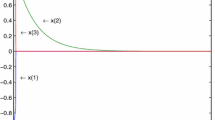Abstract
Borrowing the framework of the geometric approach, this paper tries to analyze and explain why it is possible for the extended state observer (ESO) to estimate the state vector and total disturbance accurately. The geometric approach has provided an elegant and rigorous framework to redefine some key concepts in modern control theory, such as controllability and observability. Moreover, those concepts can be extended to deal with systems in the presence of inaccessible disturbances, such as controlled invariants and conditioned invariants. It is shown in this paper that the augmented system of the ESO is unknown-state unknown-input completely reconstructable in finite time interval. A numerical simulation is given to verify the state vector and total disturbance can be estimated accurately by the ESO if the augmented system is unknown-state unknown-input completely reconstructable.

Similar content being viewed by others
References
Åström, K. J., & Kumar, P. R. (2014). Control: A perspective. Automatica, 50(1), 3–43.
Brockett, R. (2001). New issues in the mathematics of control. In D. Priya (Ed.), Mathematics unlimited-2001 and beyond (pp. 189–219). Berlin: Springer.
Tsien, H. S., & Qian, X. (1954). Engineering cybernetics. New York, NY, USA: McGraw-Hill.
Xie, L.-L., & Guo, L. (2000). How much uncertainty can be dealt with by feedback? IEEE Transactions on Automatic Control, 45(12), 2203–2217.
Stein, G. (2003). Respect the unstable. IEEE Control Systems Magazine, 23(4), 12–25.
Gao, Z. (2014). On the centrality of disturbance rejection in automatic control. ISA Transactions, 53(4), 850–857.
Zhou, K., & Doyle, J. C. (1998). Essentials of robust control. Englewood Cliffs, NJ, USA: Prentice Hall.
Edwards, C., & Spurgeon, S. (1998). Sliding mode control: theory and applications. London: CRC Press.
Krstic, M., Kokotovic, P. V., & Kanellakopoulos, I. (1995). Nonlinear and adaptive control design. New York, NY, USA: Wiley.
Han, J. (2009). From pid to active disturbance rejection control. IEEE Transactions on Industrial Electronics, 56(3), 900–906.
Chen, W.-H., Yang, J., Guo, L., & Li, S. (2015). Disturbance-observer-based control and related methods-an overview. IEEE Transactions on Industrial Electronics, 63(2), 1083–1095.
Sariyildiz, E., Oboe, R., & Ohnishi, K. (2019). Disturbance observer-based robust control and its applications: 35th anniversary overview. IEEE Transactions on Industrial Electronics, 67(3), 2042–2053.
Basile, G., & Marro, G. (1969). On the observability of linear, time-invariant systems with unknown inputs. Journal of Optimization Theory and Applications, 3(6), 410–415.
Wonham, W. M., & Morse, A. S. (1970). Decoupling and pole assignment in linear multivariable systems: a geometric approach. SIAM Journal on Control, 8(1), 1–18.
Morse, A. S., & Wonham, W. M. (1970). Decoupling and pole assignment by dynamic compensation. SIAM Journal on Control, 8(3), 317–337.
Kalman, R.E. (1960). On the general theory of control systems. In: Proceedings First International Conference on Automatic Control, Moscow, USSR, pp. 481–492 .
Basile, G., & Marro, G. (1992). Controlled and conditioned invariants in linear system theory. Englewood Cliffs, NJ, USA: Prentice Hall.
Isidori, A. (1995). Nonlinear control systems. 3rd edition. London: Springer.
Chen, J., Gao, Z., Hu, Y., Shao, S. (2022). On the relationship between extended state observer and unknown input observer. arXiv preprint. arXiv:2208.12314.
Hou, M., & Patton, R. J. (1998). Input observability and input reconstruction. Automatica, 34(6), 789–794.
Ansari, A., & Bernstein, D. S. (2019). Deadbeat unknown-input state estimation and input reconstruction for linear discrete-time systems. Automatica, 103, 11–19.
Willems, J. (1982). Almost invariant subspaces: An approach to high gain feedback design-part ii: Almost conditionally invariant subspaces. IEEE Transactions on Automatic Control, 27(5), 1071–1085.
Hovakimyan, N., Cao, C. (2010). \(\cal{L} _1\) adaptive control theory: Guaranteed robustness with fast adaptation. IEEE Control Systems Magazine, 31(5), 112–114.
Chen, W.-H., Ballance, D. J., Gawthrop, P. J., & O’Reilly, J. (2000). A nonlinear disturbance observer for robotic manipulators. IEEE Transactions on Industrial Electronics, 47(4), 932–938.
Chen, J., Hu, Y., & Gao, Z. (2021). On practical solutions of series elastic actuator control in the context of active disturbance rejection. Advanced Control for Applications, 3(2), 69.
Imai, H., & Akashi, H. (1981). Disturbance localization and pole shifting by dynamic compensation. IEEE Transactions on Automatic Control, 26(1), 226–235.
Willems, J. C., & Commault, C. (1981). Disturbance decoupling by measurement feedback with stability or pole placement. SIAM Journal on Control and Optimization, 19(4), 490–504.
Padula, F., & Ntogramatzidis, L. (2019). On the well-posedness in the solution of the disturbance decoupling by dynamic output feedback with self bounded and self hidden subspaces. Automatica, 106, 315–326.
Padula, F., & Ntogramatzidis, L. (2020). Fixed poles in the disturbance decoupling by dynamic output feedback for systems with direct feedthrough matrices. Automatica, 121, 109159.
Willems, J. (1981). Almost invariant subspaces: An approach to high gain feedback design–Part I: Almost controlled invariant subspaces. IEEE Transactions on Automatic Control, 26(1), 235–252.
Author information
Authors and Affiliations
Corresponding author
Rights and permissions
Springer Nature or its licensor (e.g. a society or other partner) holds exclusive rights to this article under a publishing agreement with the author(s) or other rightsholder(s); author self-archiving of the accepted manuscript version of this article is solely governed by the terms of such publishing agreement and applicable law.
About this article
Cite this article
Chen, J., Gao, Z. On geometric interpretation of extended state observer: a preliminary study. Control Theory Technol. 21, 89–96 (2023). https://doi.org/10.1007/s11768-023-00130-5
Received:
Revised:
Accepted:
Published:
Issue Date:
DOI: https://doi.org/10.1007/s11768-023-00130-5




